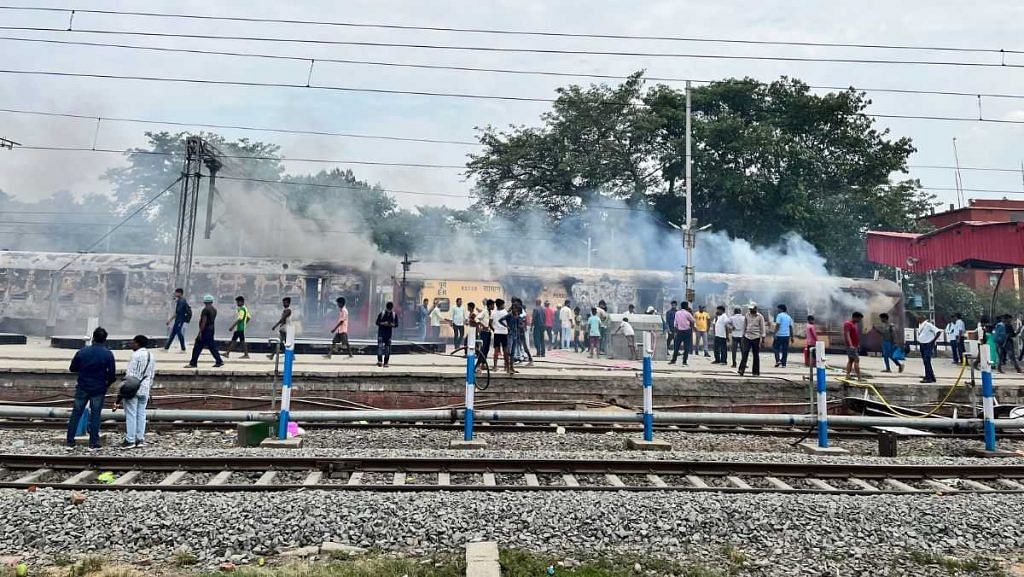The Narendra Modi government, otherwise known for its firm and brutal crackdown on violent protests, is seemingly acting coy in dealing with those protesting against Agnipath, the newly announced recruitment scheme of the Indian Armed Forces. The Yogi Adityanath government in Uttar Pradesh is no exception. Varanasi Commissioner Satish Bharadwaj said on record that these are ‘our own boys’. Uttar Pradesh’s Additional Director General of Police Prashant Kumar said that senior officials are “trying to pacify all students and aspirants.”
The protests, which have become a pain in the neck for the Union government, have erupted and turned quite violent in at least 11 states. Though it was concentrated in the north, for the most part, it has now spilled over to the southern states too.
To get into the merits and demerits of the scheme is beyond the scope of this article. I am not passing any value judgment on the scheme. I would rather try to answer only two questions here. One, who are these protesters who want this scheme to go and two, why are the government and local administrations handling these protesters with so much care and compassion?
Also Read: With Agnipath, Modi govt’s shock & awe doctrine may have misfired a vital reform, yet again
Not too different from 1990 Delhi
I have memories of 1990 when Delhi and large parts of north India went literally up in flames after the announcement of the implementation of the Mandal Commission Report. Then-Prime Minister V.P. Singh had announced on 7 August 1990 that there would be a reservation of 27 per cent of Union government jobs for Other Backward Classes. This led to protests and the burning of public property. Some even tried to burn themselves and died. At that time, too, the administration (and almost all media platforms) remained supportive of the agitators; the idea that “our boys” were protesting was clear.
In the present case, the administrations in different states, especially in UP, have sensed that those protesting are “their people.” This is unlike the case of the Muslims, who protested against the Citizenship Amendment Act and National Register of Citizens and also against the utterances of former Bharatiya Janata Party national spokesperson Nupur Sharma. When the Muslims protested, the UP administration acted harshly and brought out the bulldozers. Buildings and business establishments of many who took part in the protests were demolished. They said the structures were ‘illegally built’. The idea of razing buildings caught on, so much so that the ‘bulldozer’ suddenly became the symbol of the toughness of the government.
Also Read: Schemes like Agnipath must go to test beds first. They shake up the entire system
The difference in Agnipath protests
The difference in the treatment of the Agnipath protests may have something to do with the recruitment processes and social-religious structures of the armed forces. We don’t know the religious or caste composition of the enlisted officers and non-officers. This is unlike the United States, where the Department of Defence publishes racial diversity data. It told us that in 2020, there were 59 per cent whites and 13 per cent blacks in the US army. The department also released comprehensive data for Hispanics, Asians, Native Americans and so on.
The Sachar Committee tried to collect data on minority representation in the armed forces, but due to strong resistance mainly from the establishment, the idea was dropped. Former Defence Minister A.K. Antony at the time categorically said that religious headcount would not be allowed in the armed forces. The resistance to collecting such data was such that we may deduce that Muslims are probably not adequately represented in the forces.
Based on the televised and otherwise circulated statements of the protestors, I inferred that most of the protesters, in this case, are Hindus. This is not a group that the BJP would like to antagonise or hit hard. Despite all the talk of transformation, BJP remains a party of the Hindus. It’s also a party that takes its strength from the Hindu-Muslim binary. After the recently concluded Rajya Sabha elections, the BJP does not have a single Muslim MP. With this standpoint, BJP governments behaving differently in the case of Hindu and Muslim protestors is not a matter of surprise.
Also Read: Agnipath gives Indian military ‘four-year interns’. It’s an assault on Army bonding
Caste politics
Another reason for the BJP going soft on the agitators has to do with the transformation of the party over the years. It has long been branded as a party of the dominant caste Hindu people, mostly Brahmin-Baniya. Over the years, it has expanded its base by including new social groups. In all probability, it does not want to lose all the goodwill of this social group by going for a crackdown on the agitators because it catapulted the BJP to power in almost the entire north India.
Though caste, community and geography-based army units, a legacy and continuum of the British Indian Army, are only a small part of the entire strength of the armed forces, some geographies and social groups are still more associated with the army. Are these social groups sending proportionately more youths to the armed forces?
Without data, we can only have postulations and inferences. The way the BJP is tackling the present agitation and the way it amended the scheme just one day after announcing it and increased the maximum age from 21 to 23 as a one-time exception, is hinting that this is not the social group that the BJP would like to treat as it treats Muslims.
Dilip Mandal is the former managing editor of India Today Hindi Magazine, and has written books on media and sociology. He tweets @Profdilipmandal. Views are personal.
(Edited by Srinjoy Dey)
